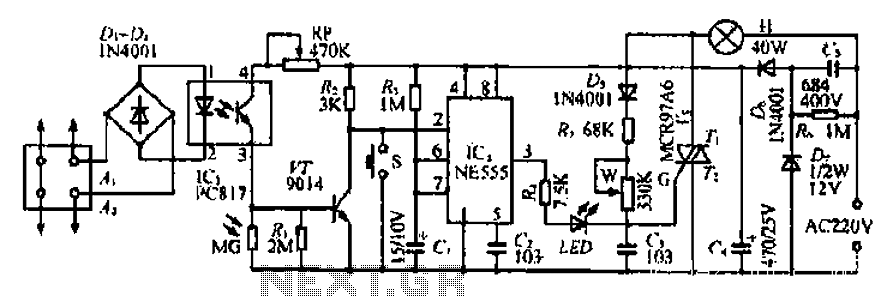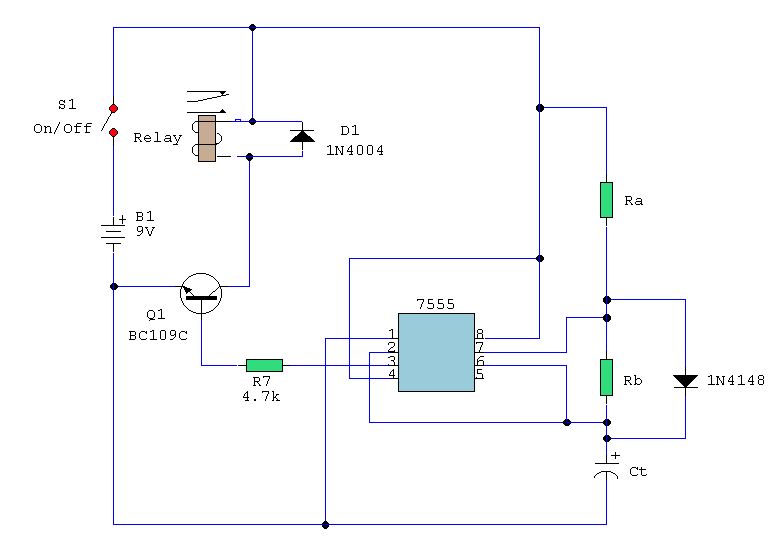
TV REMOTE JAMMER CIRCUIT USING 555 TIMER

A TV remote jammer circuit using the NE555 timer IC. This device allows users to watch their favorite TV channels without interruptions, as it prevents others from changing the channel using a remote control when the circuit is activated. The circuit is simple and cost-effective to assemble at home. The TV remote jammer operates by continuously interrupting the infrared (IR) signals emitted from the remote control. The standard operating frequency for a TV remote is 38 kHz, while this circuit generates a frequency of approximately 12 kHz. The 12 kHz frequency is produced with the help of the NE555 timer IC, with the frequency determined by a network consisting of resistors RA and RB (10 kΩ and 1 kΩ, respectively) and a capacitor (0.01 µF). The output from the IC is fed directly to a current-driving PNP transistor, SK100. This transistor acts as a switch, conducting when the output of the IC transitions into a negative cycle. When the transistor is on, it activates an IR LED that emits IR signals at a frequency of 12 kHz, which interferes with the signals from the TV remote, rendering it inoperative.
The TV remote jammer circuit primarily utilizes the NE555 timer IC configured in astable mode to generate a continuous square wave output at the desired frequency. The choice of resistors and the capacitor in the timing network is crucial as it directly influences the frequency of oscillation. In this configuration, RA and RB set the charge and discharge times of the capacitor, thereby establishing the frequency of the output waveform.
The PNP transistor SK100 is selected for its ability to handle the current required to drive the IR LED. When the NE555 output goes low, it turns on the transistor, allowing current to flow through the IR LED. This LED is designed to emit infrared light at the specified frequency of 12 kHz, which effectively disrupts the communication between the TV remote and the television set.
The overall design of the circuit is straightforward, making it accessible for hobbyists and those interested in electronics. The components required are inexpensive and readily available, allowing for easy assembly. Safety precautions should be taken into account when constructing and operating the circuit, particularly concerning the power supply and handling of electronic components. The jamming effect can be tested by attempting to use a remote control in the vicinity of the circuit to observe the disruption in functionality.A Tv remote jammer circuit, using NE555 timer IC. By using this you can watch your favorite TV channel without any interruptions. Ie; No one can be able to change the channel by means of remote, if the circuit remains ON. The circuit is simple to make at your own home, with very low cost. Let`s go deeply into the specification and requirem ents of this Project. This TV remote jammer is working on the basis, the IR rays emitted from the remote is interrupted continuously by means of this circuit. The normal operating frequency range of a TV remote is 38KHz. This circuit produces a frequency of about 12KHz. The 12KHz frequency is generated by the help of NE555 timer IC, the frequency is determined by the network consisting of RA RB and C; 10K, 1K, and 0.
01uF respectively. The output taken from the IC is given directly to a current driving PNP transistor, SK100. The transistor act as a switching network, it goes into conduction whenever the output of IC drives into negative going cycle. The conduction of transistor switch ON the IR led and emits IR rays of frequency 12Khz. This may interfere with the rays emitted from TV remote, which makes it disabled. 🔗 External reference
The TV remote jammer circuit primarily utilizes the NE555 timer IC configured in astable mode to generate a continuous square wave output at the desired frequency. The choice of resistors and the capacitor in the timing network is crucial as it directly influences the frequency of oscillation. In this configuration, RA and RB set the charge and discharge times of the capacitor, thereby establishing the frequency of the output waveform.
The PNP transistor SK100 is selected for its ability to handle the current required to drive the IR LED. When the NE555 output goes low, it turns on the transistor, allowing current to flow through the IR LED. This LED is designed to emit infrared light at the specified frequency of 12 kHz, which effectively disrupts the communication between the TV remote and the television set.
The overall design of the circuit is straightforward, making it accessible for hobbyists and those interested in electronics. The components required are inexpensive and readily available, allowing for easy assembly. Safety precautions should be taken into account when constructing and operating the circuit, particularly concerning the power supply and handling of electronic components. The jamming effect can be tested by attempting to use a remote control in the vicinity of the circuit to observe the disruption in functionality.A Tv remote jammer circuit, using NE555 timer IC. By using this you can watch your favorite TV channel without any interruptions. Ie; No one can be able to change the channel by means of remote, if the circuit remains ON. The circuit is simple to make at your own home, with very low cost. Let`s go deeply into the specification and requirem ents of this Project. This TV remote jammer is working on the basis, the IR rays emitted from the remote is interrupted continuously by means of this circuit. The normal operating frequency range of a TV remote is 38KHz. This circuit produces a frequency of about 12KHz. The 12KHz frequency is generated by the help of NE555 timer IC, the frequency is determined by the network consisting of RA RB and C; 10K, 1K, and 0.
01uF respectively. The output taken from the IC is given directly to a current driving PNP transistor, SK100. The transistor act as a switching network, it goes into conduction whenever the output of IC drives into negative going cycle. The conduction of transistor switch ON the IR led and emits IR rays of frequency 12Khz. This may interfere with the rays emitted from TV remote, which makes it disabled. 🔗 External reference





